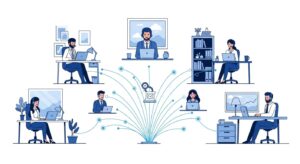
How VoIP and SIP Trunking Improve Customer Service
SIP trunking customer service solutions deliver measurable improvements in call quality, response times, and customer satisfaction.
- Companies typically achieve cost savings on monthly communication expenses while gaining advanced features.
- Intelligent call routing and real-time analytics enable faster issue resolution and improved first-call success rates.
- Automatic failover capabilities and HD voice quality create more reliable customer communication experiences.
- Multi-channel integration allows seamless transitions between voice, video, and messaging for comprehensive customer support.
Businesses serious about customer service excellence should evaluate SIP trunking as their communication foundation rather than continuing with outdated phone systems.
Customer service excellence has become the defining factor that separates thriving businesses from those that struggle to retain customers. A single poor phone experience can drive customers to competitors. Traditional phone systems create barriers to exceptional service through dropped calls, poor audio quality, and limited routing capabilities that frustrate both customers and service representatives.
The solution lies in modern SIP trunking technology that revolutionizes how businesses handle customer communications. The global SIP trunking market is growing rapidly as companies abandon legacy systems for internet-based communications. VoIP and SIP trunking enhance customer service by delivering crystal-clear call quality, intelligent routing, and real-time analytics that empower service teams to exceed expectations.
How Do VoIP and SIP Trunking Impact Customer Service?
Voice over Internet Protocol (VoIP) is the foundation of internet-based communication systems. Rather than relying on copper wires and circuit-switched networks, VoIP converts voice signals into digital data packets that travel over your existing internet connection. Businesses benefit from higher quality audio, advanced features, and cost savings compared to legacy phone systems.
SIP trunking takes VoIP further by creating virtual phone lines that connect your business phone system to the public telephone network through the internet. Session Initiation Protocol manages how calls are initiated, maintained, and terminated, ensuring seamless communication between your customer service team and callers regardless of their location or device type.
The technology works by establishing secure connections between your IP-enabled phone system and your SIP provider’s network infrastructure. When customers call your business, SIP protocols route their calls through multiple pathways to ensure optimal connection quality and reliability. This redundant architecture eliminates the single points of failure that plague traditional phone systems, creating a more dependable customer service experience.
For customer service departments, this technology stack provides capabilities that were previously impossible with conventional telephone systems. Advanced call routing algorithms can instantly direct customers to the most qualified available agent based on caller ID information, previous interaction history, or specific product needs.

What Are the Core Customer Service Benefits of SIP Trunking?
SIP trunking delivers tangible improvements that directly impact how customers experience your business. The following benefits demonstrate why forward-thinking companies are transitioning from traditional phone systems to VoIP for customer service operations.
Enhanced Call Quality and Reliability
SIP call quality surpasses traditional telephone systems through advanced codec technology and bandwidth optimization. High-definition voice codecs like G.722 deliver twice the audio frequency range of standard telephone calls, making conversations clearer and reducing miscommunication. Customer service representatives can better understand customer concerns, while customers experience professional, crisp audio that reflects positively on your brand.
The reliability improvements are equally significant. SIP trunking enhances customer service through automatic failover capabilities that reroute calls during network disruptions, ensuring customers always reach your service team. Unlike traditional phone lines that can be severed by construction accidents or weather events, SIP traffic can automatically redirect through alternative internet pathways within seconds of detecting connectivity issues.
Intelligent Call Routing and Queue Management
Advanced call routing transforms how customers navigate your service system. Interactive Voice Response systems integrated with SIP trunking can access customer databases in real time, personalizing the experience based on account history, purchase patterns, or previous service interactions. Customers spend less time explaining their situation because the system provides context to service representatives before the call connects.
Skills-based routing ensures customers reach agents with the specific expertise needed to efficiently resolve their issues. The system can evaluate agent availability, language capabilities, product specializations, and current call volume to make routing decisions. This intelligent matching reduces call transfers and improves first-call resolution rates.
Real-Time Analytics and Performance Monitoring
SIP trunking customer service platforms provide comprehensive call analytics that enable continuous service improvement. Managers can monitor real-time metrics, including average wait times, call abandonment rates, agent performance, and customer satisfaction trends. This visibility allows for immediate adjustments when service levels decline, ensuring consistent customer experiences.
Historical reporting reveals patterns in customer behavior, peak calling periods, and common issue types. Service managers can use this data to optimize staffing schedules, identify training needs, and proactively address recurring customer concerns before they escalate.
Multi-Channel Communication Integration
Modern SIP systems enable seamless integration between voice calls, video conferences, instant messaging, and email communications. Customer service representatives can escalate a voice call to a video session when visual demonstration would help resolve technical issues. Text messaging allows for follow-up communications, appointment confirmations, and service updates that customers prefer over phone calls.
This unified approach creates consistent service experiences across all channels. Customer history and preferences remain accessible regardless of how they choose to contact your business, enabling personalized service that builds stronger customer relationships.
Cost-Effective Scalability
Business communication improvement through SIP trunking includes cost advantages. Traditional phone systems require expensive hardware installations and long-term contracts that limit flexibility. SIP solutions scale instantly through software configuration, allowing businesses to add customer service capacity during peak periods without capital investments.
Companies switching to SIP typically save between 25% and 65% on monthly communication costs, creating budget flexibility that can be redirected toward customer service training, additional staff, or service quality improvements.
Before and After: Customer Service Transformations
Real-world business scenarios illustrate how SIP trunking transforms daily operations and customer experiences. These hypothetical examples, based on typical experiences, demonstrate the measurable improvements companies can achieve when transitioning from traditional phone systems to modern VoIP solutions.
Manufacturing Company Scenario
Before SIP Implementation: Consider a mid-sized manufacturing company struggling with outdated phone infrastructure that creates customer service challenges. Traditional PRI lines frequently experience outages during severe weather, leaving customers unable to reach technical support when equipment failures occur. Call quality is inconsistent, leading to miscommunication about technical specifications and delivery schedules. The company pays $1,200 monthly for phone service that supports only 12 concurrent calls, creating bottlenecks during peak periods.
Customer service metrics reveal significant problems. Average call wait times exceed eight minutes during busy periods, with 15% of customers abandoning calls before reaching an agent. First-call resolution rates remain below 60% due to poor call routing that connects customers with agents lacking specific product expertise. The customer service manager spends hours manually adjusting call forwarding rules when agents are unavailable, creating inefficiencies that impact service quality.
After SIP Trunking Implementation: The transformation begins with deploying SIP trunking that provides unlimited concurrent calling capacity for $350 monthly, a substantial cost reduction. High-definition voice quality eliminates communication errors about technical specifications, while automatic failover ensures consistent uptime.
Intelligent call routing directs customers to specialized technical support agents based on product types and issue categories. IVR integration with the company’s CRM system provides agents with customer history, previous service interactions, and current equipment status before calls connect. This preparation enables agents to resolve issues more efficiently and demonstrate proactive service awareness.
Results appear within the first month. Average wait times drop, while call abandonment rates fall. First-call resolution improves through better agent-customer matching and comprehensive call preparation. The company reinvests phone service savings into additional technical training and expanded customer service hours, further improving customer satisfaction scores.
Professional Services Firm Transformation
Before Implementation: Consider a legal services firm with offices in three cities struggling to maintain consistent client communication standards. Traditional phone systems create disjointed experiences where clients calling different office numbers reach different voicemail systems and service protocols. Partners working remotely miss important client calls because the phone system can’t reliably forward calls to mobile devices.
Client complaints center on difficulty reaching the right attorney, inconsistent call quality during important conferences, and delays in receiving return calls. The firm pays separate phone bills for each office location, totaling $850 monthly, while lacking centralized reporting on client communication patterns.
After SIP Transformation: SIP trunking unifies all office locations under a single communication system with consistent caller experiences, regardless of the dialed number. Sophisticated call routing connects clients with the appropriate attorney or assistant based on matter type, urgency level, and availability status. Remote attorneys can seamlessly handle calls through softphone applications on smartphones and laptops.
Video calling enables face-to-face client consultations without requiring in-person meetings, improving convenience for clients while reducing travel costs. Call recording features ensure accurate documentation of client communications, improving case management and reducing liability concerns.
The implementation delivers immediate improvements in client satisfaction. Response times decrease through intelligent routing and mobile integration. Monthly communication costs drop to $320 while providing enhanced capabilities across all locations. Client feedback scores improve, with specific praise for improved responsiveness and communication reliability.

Which SIP Features Drive Customer Service Excellence?
SIP call quality improvements stem from several technical advances that directly impact customer service delivery. Adaptive jitter buffering automatically adjusts for network variations, ensuring consistent audio quality even when internet traffic fluctuates. Packet loss concealment algorithms maintain call clarity when minor network issues occur, preventing the choppy audio that frustrates customers and agents alike.
Quality of Service protocols prioritize voice traffic over other internet activities, guaranteeing that customer calls receive the bandwidth needed for crystal-clear communication. These technical features work transparently in the background, creating professional call experiences that enhance your business reputation.
Advanced codec selection allows optimization for different scenarios. G.711 provides the highest audio quality for internal networks with ample bandwidth, while G.729 compression enables excellent call quality over limited internet connections. Automatic codec negotiation ensures optimal quality settings for each call based on network conditions.
Echo cancellation and noise suppression technologies eliminate distracting background sounds that can interfere with customer conversations. These features are particularly valuable for businesses with open office environments or agents working from home, ensuring professional call quality regardless of the physical environment.
Session border controllers provide enterprise-grade security that protects communications from eavesdropping and unauthorized access. Encryption protocols secure call content during transmission, while authentication mechanisms prevent toll fraud and unauthorized system access.

How Does SIP Trunking Impact Customer Satisfaction Metrics?
Businesses implementing VoIP for customer service consistently report measurable improvements in key performance indicators that directly correlate with customer satisfaction.
Call abandonment rates typically decrease as improved routing and reduced wait times keep customers connected. The elimination of busy signals through unlimited concurrent calling ensures customers can always reach your service team when needed. Advanced queue management provides accurate wait time estimates and callback options that reduce customer frustration during high-volume periods.
CRM integration enables agents to instantly access customer history, reducing the time needed to understand issues and provide relevant solutions. Automatic screen population with customer information eliminates manual lookup delays that previously extended call duration.
Customer feedback scores reflect these operational improvements through higher satisfaction ratings and increased loyalty metrics. Businesses often see substantial improvements in customer advocacy and referrals after switching to SIP.
The technology also enables proactive customer service strategies that prevent issues before they require phone calls. Automated appointment reminders, service notifications, and follow-up communications reduce inbound call volume while improving customer experiences through convenient, timely information delivery.
How to Select the Right SIP Provider for Customer Service Excellence
Choosing an effective SIP trunking customer service solution requires evaluating providers based on reliability, feature set, and support quality. Best-in-class VoIP phone systems for small businesses include redundant network infrastructure, 24/7 technical support, and transparent pricing models that scale with business growth.
Network reliability should be your primary consideration, as customer service departments can’t tolerate communication outages. Look for providers offering Service Level Agreements guaranteeing high uptime, with automatic failover capabilities and geographically diverse data centers. Redundant network paths ensure call completion even when individual network components experience problems.
The SIP provider should integrate seamlessly with your CRM system, call center software, and other business applications. API availability enables custom integrations that optimize the system for your specific customer service processes.
Providers should offer dedicated technical support with direct access to qualified engineers who understand customer service requirements. Implementation assistance, training resources, and proactive monitoring help ensure successful deployment and continued optimization.
Pricing transparency helps predict long-term costs and plan for growth. Avoid providers with hidden fees, complex billing structures, or significant rate increases after promotional periods. The best providers offer simple, predictable pricing that scales efficiently as your customer service team grows.
Business Communication Improvement Through Advanced Features
Modern SIP systems enable business communication improvements beyond call handling. Unified communications platforms integrate voice, video, messaging, and collaboration tools into cohesive systems that support comprehensive customer service strategies.
Presence management features help customers understand agent availability and expected response times, managing expectations and reducing frustration. Customers can see when their preferred service representative is available and choose to wait or schedule callbacks accordingly.
Call recording enables quality assurance programs that drive continuous service improvement. Managers can review interactions to identify training opportunities, recognize exceptional performance, and ensure compliance with industry regulations. Automated recording policies ensure consistent documentation while respecting privacy.
Mobile integration extends customer service capabilities beyond traditional office environments. Agents can handle customer calls while working remotely, maintaining service levels during emergencies, travel, or flexible work arrangements. Softphone applications provide full-feature access from smartphones and tablets, ensuring customers receive consistent service regardless of agent location.
Integration with business intelligence systems enables predictive analytics that anticipate customer service trends and optimize resource allocation. Historical calling patterns help predict peak periods, while customer behavior analysis identifies opportunities for proactive service interventions.

Frequently Asked Questions
How quickly can SIP trunking improve customer service metrics?
Most businesses see improvements in call quality and routing efficiency within the first week of implementation. Measurable improvements in customer satisfaction scores typically appear within a couple of months as staff become proficient with new features and customers experience consistently better service.
What happens to our customer service during the transition to SIP trunking?
Professional SIP providers offer seamless transition services that maintain continuous service during implementation. Number porting ensures customers can reach you using existing phone numbers, while parallel system operation allows testing before full cutover.
How does SIP trunking handle high call volumes during customer service emergencies?
SIP systems scale instantly to handle unexpected call volume spikes. Automatic overflow routing can direct calls to backup agents or alternative locations, while queue management features keep customers informed about wait times and provide callback options.
Can SIP trunking integrate with our existing customer service software?
Most modern SIP platforms offer extensive integration capabilities through APIs and pre-built connectors. Popular CRM systems, helpdesk software, and call center applications typically integrate with enterprise SIP solutions.
Transform Your Customer Service with Professional SIP Solutions
Businesses that implement SIP trunking customer service solutions gain advantages through improved call quality, advanced routing capabilities, and comprehensive analytics. Your customers expect reliable, professional communication experiences that traditional phone systems can’t consistently deliver.SIP.US provides enterprise-grade solutions with instant provisioning, comprehensive feature sets, and the reliability your customer service team needs to exceed expectations. Get started today and discover how SIP trunking can transform your customer service capabilities.



